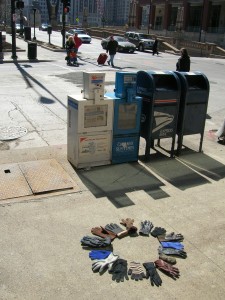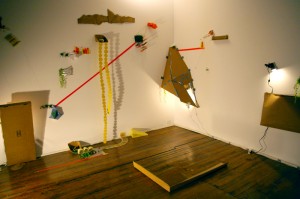February – March 2007, Chicago & New York, USA

Found gloves. The Glove Project. Image supplied by the artist.
What I particularly enjoyed was the intensity that only a residency can allow. The routine of making art all day with out the interruption of work/family/commitments of any type was truly a joy! The flow that arose was very fulfilling. I did the residency with two other Melbourne artists and three Scottish artists. While the studio and exhibition space could not have been more professional and accommodating, the living space was very small. We were extremely lucky in that we all got along superbly, we all lived together well and we all took the project on with full presence and seriousness. I can honestly say that I think none of us could have worked harder. We were lucky in that we all had a fair amount in common socially and creatively. This is not to say that there was not space for healthy difference. I was amazed at the generosity of spirit, ideas and equipment from the Edinburgh side. It was pretty contagious and fairly soon, we were all shopping for one another, sharing all the equipment and helping out with technical and physical challenges in the works.
One of the interesting differences between us was the difference in priority or hierarchies when assessing art. In Melbourne people put more emphasis on a thorough understanding of works, we all talked about our work in a broad context and understanding of our own process and influences. The Edinburgh emphasis was more on refining or distilling an idea. I think they also had an extremely sharp sense of the entire exhibition and how the works would look together. I enjoyed and learnt a lot from their input when the art was finally made.

Untitled, installation detail 1. Various materials. Image supplied by the artist.
The residency program is generous in time and I would say that the programs strength is clearly in their network. A residency at Location One would allow contact and connection with New York’s vibrant new media scene, its facilitators and curators. The staff seemed to support their artists generously in this way. While there are limited technical facilities, I have no doubt that regardless of what your practice needed, Sebastien Sanz de Santamaria – Creative/Technical coordinator, would track it down for you. It was a really fantastic opportunity to be able to see their residency program, before I committed to a four or six month residency. I got to see if their program accommodated my needs. It’s often hard to tell from a web site. All in all, my time in the USA was remarkably fruitful. It has had a big impact on not only the work I am doing, but also I how I work.
Tags: art and futurism, digital arts, performing arts, utopian concepts, visual arts




